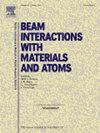Elemental analysis of automobile engine lubrication oil using in-air PIXE
IF 1.4
3区 物理与天体物理
Q3 INSTRUMENTS & INSTRUMENTATION
Nuclear Instruments & Methods in Physics Research Section B-beam Interactions With Materials and Atoms
Pub Date : 2025-02-01
DOI:10.1016/j.nimb.2024.165601
引用次数: 0
Abstract
To identify the elemental characteristics of engine lubricating oil-derived particles emitted from automobiles, we established an elemental analysis technique for engine lubricating oils using the in-air PIXE method, and conducted elemental analysis of unused and used engine lubrication oils, which revealed that S and Ca found in the internal standard base oil Sc 2000 wt-ppm (CONOSTAN®) and In 1000 wt-ppm (CONOSTAN®) were detected in addition to P, Fe and Zn, while K was detected only in the unused engine oil. The concentration balance of P, S, and Zn in the unused and used engine oil confirmed the presence of zinc dialkyldithiophosphate (ZnDTP), which is added to engine lubricating oil as a friction modifier and antioxidant. These results are useful in characterizing the elemental composition of particles derived from engine lubricating oils.
汽车发动机润滑油在空气中的元素分析
为了确定汽车排放的发动机润滑油衍生颗粒的元素特征,我们采用空气中PIXE法建立了发动机润滑油元素分析技术,并对未使用和使用过的发动机润滑油进行了元素分析,结果表明,除P、Fe和Zn外,在内部标准基础油Sc 2000 wt-ppm (CONOSTAN®)和in 1000 wt-ppm (CONOSTAN®)中还检测到S和Ca。而K仅在未使用的发动机油中检测到。通过对未使用和用过的发动机油中P、S、Zn的浓度平衡,确定了二烷基二硫代磷酸锌(ZnDTP)的存在,并将其作为摩擦改进剂和抗氧化剂添加到发动机润滑油中。这些结果对表征发动机润滑油中衍生的颗粒的元素组成是有用的。
本文章由计算机程序翻译,如有差异,请以英文原文为准。
求助全文
约1分钟内获得全文
求助全文
来源期刊
CiteScore
2.80
自引率
7.70%
发文量
231
审稿时长
1.9 months
期刊介绍:
Section B of Nuclear Instruments and Methods in Physics Research covers all aspects of the interaction of energetic beams with atoms, molecules and aggregate forms of matter. This includes ion beam analysis and ion beam modification of materials as well as basic data of importance for these studies. Topics of general interest include: atomic collisions in solids, particle channelling, all aspects of collision cascades, the modification of materials by energetic beams, ion implantation, irradiation - induced changes in materials, the physics and chemistry of beam interactions and the analysis of materials by all forms of energetic radiation. Modification by ion, laser and electron beams for the study of electronic materials, metals, ceramics, insulators, polymers and other important and new materials systems are included. Related studies, such as the application of ion beam analysis to biological, archaeological and geological samples as well as applications to solve problems in planetary science are also welcome. Energetic beams of interest include atomic and molecular ions, neutrons, positrons and muons, plasmas directed at surfaces, electron and photon beams, including laser treated surfaces and studies of solids by photon radiation from rotating anodes, synchrotrons, etc. In addition, the interaction between various forms of radiation and radiation-induced deposition processes are relevant.

 求助内容:
求助内容: 应助结果提醒方式:
应助结果提醒方式:


